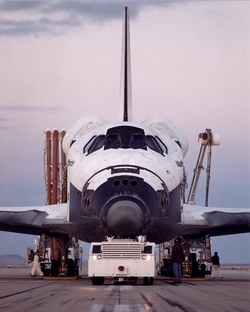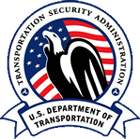Is The TSA Killing Us? A CATO Institute Perspective
 According to our count,
from 1981 to 2003 there were 113 space shuttle missions that
collectively carried about 655 people. Two missions ended with the
loss of the crew, killing a total of 14 persons. Thus, an astronaut
had about two chances out of hundred of being killed anytime he or
she flew. If you had a chance to fly on the shuttle, and knew that
you had about a 2 percent chance of getting killed, would you do
it?
According to our count,
from 1981 to 2003 there were 113 space shuttle missions that
collectively carried about 655 people. Two missions ended with the
loss of the crew, killing a total of 14 persons. Thus, an astronaut
had about two chances out of hundred of being killed anytime he or
she flew. If you had a chance to fly on the shuttle, and knew that
you had about a 2 percent chance of getting killed, would you do
it?
You may not, but clearly there are many people who would take
the chance. Some very "extreme sports" or stunts probably have
fatality rates of 2 percent or more, and people engage in them,
knowing the danger. The shuttle, at least, has the advantage of
adding to man's scientific knowledge.
The question remains, how safe should space exploration be for
the United States to engage in it?
Flying in an airplane was very risky 100 years ago when the air
age began, but people learned from mistakes and now airplane travel
is the safest mode of transportation. For space travel to be as
safe as air travel 100 years from now, the unfortunate fact is some
will have to die in the meantime.
Scientific breakthrough involves risk, travel involves risk. In
fact, everything we do involves risk. We cannot eliminate all
risks, nor should we try. What we should do is educate ourselves
about relative risks and then make informed decisions about which
activities we wish to undertake.
The explorers and travelers across the Atlantic Ocean in the
1500s and 1600s experienced fatality rates of about 30 percent.
Many of our ancestors were willing to take that extreme risk to
bring their families to the new world. Over the years, safety did
improve on the transatlantic voyages, but it was probably not until
the age of steam that one could expect the present survival rate
greater than that of a shuttle astronaut on such a voyage.
Benjamin Franklin, Thomas Jefferson, and John and Abigail Adams
all made multiple trips across the Atlantic, and knew that chances
of dying on the voyage were well in excess of the 2 percent rate
that the shuttle astronauts face. People were amazed that the Lewis
and Clark team actually made it back without a large number of
fatalities.
 We are all rightly
concerned about the deaths of our soldiers in Iraq, when an average
of one a day is being killed. However, about one person a day is
killed in Washington, and the vast majority of these deaths are
among young males. The uncomfortable fact is that an 18-year-old
American living in our nation's capital has a greater chance of
being killed than an 18-year-old American soldier in Iraq.
We are all rightly
concerned about the deaths of our soldiers in Iraq, when an average
of one a day is being killed. However, about one person a day is
killed in Washington, and the vast majority of these deaths are
among young males. The uncomfortable fact is that an 18-year-old
American living in our nation's capital has a greater chance of
being killed than an 18-year-old American soldier in Iraq.
One can make a plausible argument that the Department
of Homeland Security's Transportation Safety Administration (TSA)
is unnecessarily killing us by unwittingly forcing people into
automobiles, which are less safe than airplanes.
Again, a few facts: No one was killed on a scheduled airline
last year, which TSA bills as a great success. However, there has
been a very big drop in airline passenger miles traveled. We know
that some reasonable share of the drop in airline travel had to do
with the lengthy delays caused by TSA, and their often
unnecessarily degrading treatment of the traveling public. We know
that many people, particularly on the shorter routes, have opted to
drive rather than put up with the harassment of TSA.
 We also know that airline
travel is about 20 times as safe as automobile travel. The
preliminary data indicates that several hundred people may have
died in their automobiles last year as a result of not flying.
We also know that airline
travel is about 20 times as safe as automobile travel. The
preliminary data indicates that several hundred people may have
died in their automobiles last year as a result of not flying.
It is obvious that TSA is not doing an adequate
cost-benefit analysis. It is spending too much time and effort on
seizing little old ladies' tweezers. A more rational approach would
lead away from object fixation -- Swiss Army knives, etc., which,
in the pockets of most American males flying, make the plane safer,
by giving them a weapon -- to focusing on those individuals who are
a real danger. Such an approach would make the airport experience
more pleasant, which would get people out of their cars and back
into airplanes, where they are safer.
Politicians and government bureaucrats are not good
at recognizing the unintended consequences of their own actions.
The Food and Drug Administration has long been more concerned about
approving a drug that may kill someone, than delaying or not
approving a drug that may save many lives.
A free and economically efficient society works best when people
have information about relative risks. Government provides a
service when it publicizes the statistics that airplanes are 20
times safer than automobiles, and that automobiles are 20 times
safer than motorcycles or bicycles. It is good to know that
cigarette smoking is harmful to one's health, that certain drugs
have some side effects, and that too many calories and too much
sugar may make you fat.
However, overly aggressive attempts by government to regulate or
control some types of risky behavior in the population often have
unintended side effects. Certain risks are worth taking for some
people -- some like to skydive. The real danger to our well being
and future advancement is ignorance about the probabilities of
various activities and behaviors. Most people, most of the time,
will behave in a relatively rational manner, and thus government
should leave them alone unless they are a clear and present danger
to others.
Richard W. Rahn is an adjunct scholar of the Cato
Institute.
 Classic Aero-TV: The Switchblade Flying Car FLIES!
Classic Aero-TV: The Switchblade Flying Car FLIES! ANN FAQ: Q&A 101
ANN FAQ: Q&A 101 ANN's Daily Aero-Term (04.12.24): Discrete Code
ANN's Daily Aero-Term (04.12.24): Discrete Code ANN's Daily Aero-Term (04.13.24): Beyond Visual Line Of Sight (BVLOS)
ANN's Daily Aero-Term (04.13.24): Beyond Visual Line Of Sight (BVLOS) ANN's Daily Aero-Linx (04.13.24)
ANN's Daily Aero-Linx (04.13.24)





